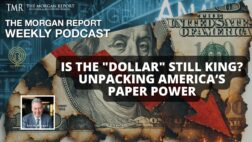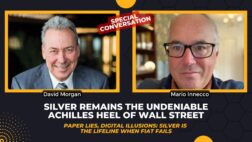Richard (Rick) Mills
Ahead of the Herd
As a general rule, the most successful man in life is the man who has the best information
Silver is winning market share from gold buyers.
2008 – In March 2008, sales increased nine times over the month before – 200,000 to 1,855,000.
In April 2008, the United States Mint had to start an allocation program, effectively rationing Silver Eagle bullion coins to authorized dealers on a weekly basis due to “unprecedented demand.”
On June 6, 2008, the Mint announced that all incoming silver planchets were being used to produce only bullion issues of the Silver Eagle and not proof or uncirculated collectible issues.
The 2008 Proof Silver Eagle became unavailable for purchase from the United States Mint in August 2008. The US Mint suspended sales of the silver bullion coins to its network of authorized purchasers twice during the year.
20,583,000 Bullion American Silver Eagles were sold in 2008. Silver averaged $14.99 an ounce and almost 80 percent more American Silver Eagles were sold then in any previous year.
“During 2008 there was a record inflow of over 93.1 million ounces (Moz) into the three main silver ETFs. Coins and medals fabrication jumped by an astonishing 63% to a record of 64.9 Moz. The main reason for this was a surge in investment-related purchases of bullion coins, both in the United States and Europe. Notably, fabrication of the U.S. Silver Eagle bullion coin achieved a record 19.6 Moz, approximately double the 2007 figure, and would have been higher if the U.S. Mint had sufficient blanks to produce coins to meet demand.” silverinstitute.org
2009 – 30,459,000 Bullion American Silver Eagles were sold.
On March 5, 2009, the United States Mint announced that the proof and uncirculated versions of the Silver Eagle coin for that year were temporarily suspended due to continuing high demand for the bullion version.
On October 6, 2009, the Mint announced that the collectible versions of the Silver Eagle coin would not be produced for 2009.
The sale of 2009 Silver Eagle bullion coins was suspended from November 24 to December 6 and the allocation program was re-instituted on December 7.
Total ETF holdings rose by 132.5 Moz and ended the year at 397.8 Moz. Coins and medals fabrication rose 21 percent to post a new record of 78.7 Moz.
Silver Eagle bullion coins sold out on January 12, 2010.
The average cost of an ounce of silver in 2009 was $14.67
2010 – No proof Silver Eagles were released through the first ten months of the year, and there was a complete cancellation of the uncirculated Silver Eagles.
Production of the 2010 Silver Eagle bullion coins began in January instead of December as usual. The coins were distributed to authorized dealers under an allocation program until September 3.
Silver posted an average price of $20.19 in 2010. World investment rose by an 40 percent in 2010 to 279.3 million troy ounces (Moz).
“Exchange traded funds (ETFs) registered another sterling performance in 2010, with global ETF holdings reaching an impressive 582.6 Moz, representing an increase of 114.9 Moz over the total in 2009. A significant boost in retail silver investment demand paved the way for higher investment in both physical bullion bars and in coins and medals in 2010. Physical bullion bars accounted for 55.6 Moz of the world investment in 2010. Coins and medals fabrication rose by 28% to post a new record of 101.3 Moz. In the United States, over 34.6 million U.S. Silver Eagle coins were minted, smashing the previous record set in 2009 at almost 29 million.” silverinstitute.org
2011 – Silver posted an annual average price of $35.12 in 2011, more than double the $14.67 average price for 2009.
Global investment in silver bars and coins & medals produced yet another historic high of 282.2 million ounces – the equivalent of $10 billion, itself a record high.
Physical silver bar investment grew by 67 percent in 2011 to 95.7 million ounces, global coins & medals fabrication rose by roughly 19 percent to an all-time high of 118.2 million ounces.
The US imported 6,600,000 oz of silver for consumption in 2011 – up from 2007’s imports of 4,830,000 oz.
In 2011 the US Mint sold 40,020,000 Bullion American Silver Eagle Coins.
2012 – United States Mint Authorized Purchasers (AP’s) ordered 3,197,000 Bullion American Silver Eagle Coins on January 3rd, the first day they went on sale. That opening day total catapulted January Bullion Eagle sales higher than half of the monthly totals in 2011.
As of January 25th 2012, 5,547,000 Bullion American Silver Eagle Coins had been sold.
From February to September monthly sales were weaker then the corresponding months in 2011.
In October demand started to pick up. In November, bullion sales took off with sales of American Silver Eagles more than doubling the figures from November and December 2011.
On December 17th the Mint said all remaining inventories of 2012 dated Silver Eagle bullion coins had sold out – no additional coins would be struck.
Since the 2013 dated coins would not be available to order until January 7, 2013 that left a three week void where no one was buying silver Eagles – yet Decembers sales were the third highest on record!
In 2012, the US Mint’s silver coin sales surpassed the amount of physical silver produced via US domestic mine production.
2013 – On January 7th the new 2013 one ounce Silver Eagle bullion coins went on sale and a new record of nearly 4 million were sold that day.
According to David Baker over at the Sprott Group:
- The US Mint’s silver coin sales reached an all-time high of 13.2 million ounces in the first three months of 2013. If annualized, the Mint would sell 52.8 million ounces of silver in 2013 – a new record.
- The SPDR Gold Trust (GLD) has dumped 141 tonnes of gold year-to-date (March 22nd) while at the same time silver ETF’s added more than 20 million ounces of silver.
- Finally from David comes the fact investors are buying 56 times more silver ounces than gold ounces – ask yourself if silver is 56 times more available then gold?
The twin policies of zero interest rates and the continual creation of money and credit being enacted today, by all governments and central banks, means that the purchase of precious metals is the only way to protect the value of your assets.
“The major monetary metal in history is silver, not gold.” Milton Friedman, Nobel Laureate
Investors are currently risk adverse and mining stocks are not well understood by the general investing public, but at least one thing is going to become very apparent to most – the best way to hedge yourself against inflation could be owning silver and the shares of a silver and gold producer.
Junior resource companies offer the greatest leverage to increasing demand and rising prices for silver. Junior resource companies are soon going to have their turn under the investment spotlight and should be on every investors radar screen.
If this is Silver’s Second Age we need to get ourselves some silver, both bullion and the leverage of shares.



